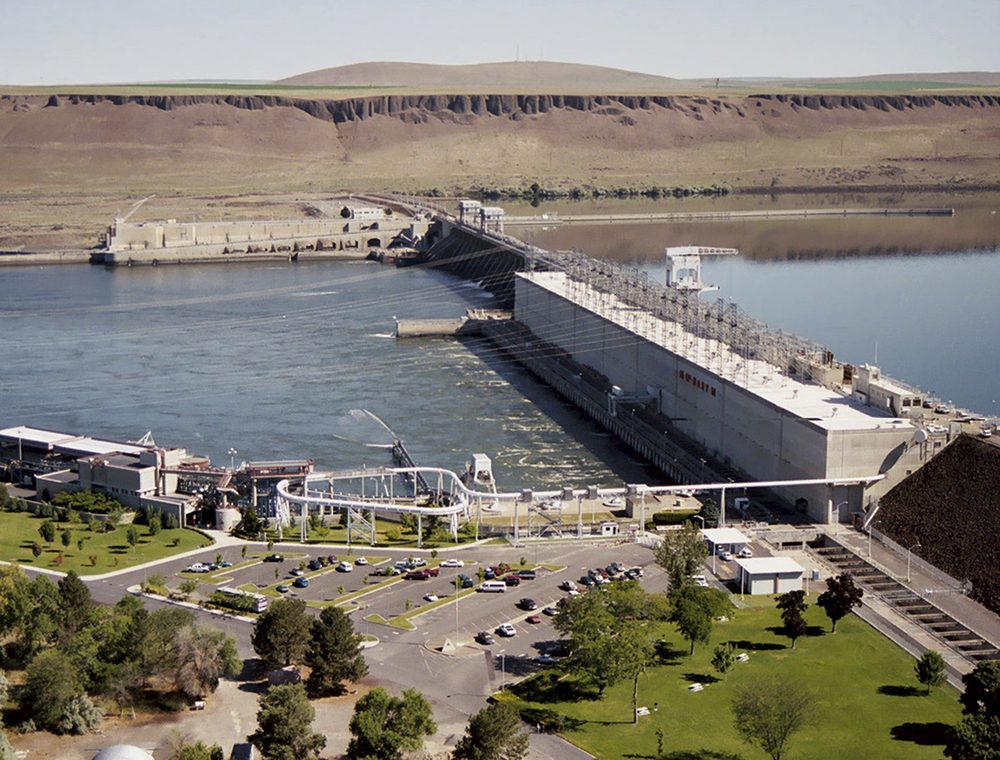
Home » U.S. and Canada reach tentative deal on Columbia River Treaty update
Environment
U.S. and Canada reach tentative deal on Columbia River Treaty update
Existing treaty has been in place since the 1960s

McNary Lock and Dam was authorized by Congress for power and navigation in the 1945 Rivers and Harbors Act. Construction began in 1947, and all turbine units were operational in 1957. Lake Wallula extends upstream of the dam for 64 miles to Hanford and has over 242 miles of shoreline.
Courtesy U.S. Bureau of ReclamationJuly 12, 2024
The United States and Canada have reached a preliminary agreement renewing and modernizing the Columbia River Treaty, which has governed the river’s dams and reservoirs for 60 years.
President Joe Biden on July 11 announced the tentative pact while Canadian Prime Minister Justin Trudeau was visiting Washington, D.C. It will be finalized in the coming weeks.
Since 1964, the treaty has managed hydropower production and flood control operations along the river – a waterway crucial to both countries’ economies. The two nations began negotiations in 2018 to update the agreement to address changing needs.
The deal announced July 11 aims to rebalance hydropower generation between the two countries while improving environmental stewardship, preparing for greater flood risk, and working with tribes and other communities along the river, according to the White House.
Once finalized, it will guide management of the river and some of its tributaries for the next 20 years.
The long-awaited agreement was welcomed by many who say it will improve power generation between the two countries. But it disappointed others who say it does not do enough to support the river’s health and its salmon populations.
Sen. Maria Cantwell, a Washington Democrat who has helped lead the push for an updated treaty, said the agreement is a positive step to optimize the state’s hydroelectric system.
“I appreciate President Biden and Prime Minister Trudeau reaching a smart agreement to grow clean energy capacity in both countries and create opportunities for future cooperation that could expand electricity generation at a time when the region has big demands for more power,” Cantwell said in a statement.
The Columbia River basin and the dams within it generate 40% of the United States hydropower, irrigate $8 billion in crops and carry 42 million tons of commercial cargo every year.
Under the treaty, Canada is entitled to some of the power generated in the U.S. in exchange for allowing the U.S. access to water storage behind Canada’s dams, which are used for flood control and flow control for fish and irrigation.
The newly proposed terms will result in a substantial reduction in power given to Canada in an effort to rebalance the system. Immediately, there will be a 37% cut in the hydropower that the U.S. delivers to Canada. By 2033, there will be a 50% reduction from current levels.
Under the existing treaty, the provision allowing flood storage in Canada automatically ends this year. The new agreement again provides the U.S. with storage in Canadian reservoirs and will allow for more certainty in flood risk management, according to the White House.
The U.S. will make a direct payment to Canada of about $37.6 million over the next 20 years in exchange for the storage space, according to senior Biden administration officials.
Canada will gain some added flexibility with how much space it reserves for the U.S.
Neil Maunu, executive director at the Pacific Northwest Waterways Association, praised the framework, which he said will help with transportation, flood control and hydropower in the region.
“There will be many long days ahead to ensure the details of a modernized treaty and operations plan meet the requirements of our industry,” Maunu added in a statement.
Environmental concerns
Conservation groups, tribal organizations and other local community members had pushed for the new treaty to focus more on the environmental management of the river basin, specifically to benefit salmon.
But Joseph Bogaard, at Save Our Wild Salmon Coalition, said the initial agreement does not put enough of an emphasis on the river’s health and salmon recovery needs, and instead continues to focus primarily on power production and flood management.
“That’s a missed opportunity,” Bogaard said. “It makes harder work for everyone else in the basin if the treaty is not there to be a tool that can contribute to solving problems.”
Bogaard also chairs the Columbia River Treaty NGO Caucus, a coalition of advocates and nonprofit organizations that focuses on conservation in the Columbia River Basin. He said his group was disappointed with the agreement and that many details on its ecological benefits remain unclear.
Biden administration officials said the new agreement will allow the U.S. to continue working with Canada to increase river flow during the spring and summer to help salmon.
But Bogaard said conservationists were hoping for an even larger increase in the amount of water that flows when the fish are migrating, which he said is crucial for salmon.
Under the new agreement, not much will change for salmon, he said.
“The agreement focuses on revenue for [the Bonneville Power Administration] and customers while the salmon and Columbia River are left with a status quo that was already inadequate,” said Bill Arthur, chair of the Sierra Club’s Snake/Columbia River salmon campaign.
During the last few years of negotiations on the agreement, conservation organizations and tribal governments in the U.S. expressed concerns that the United States was not doing enough to take their voices into consideration. They called on the Biden administration to be more transparent and inclusive.
To increase tribal collaboration, the agreement will set up a new body with government officials and tribal representatives that will make recommendations on environmental issues, particularly about salmon.
Bogaard said the new governing body is a move in the right direction, but a lot will depend on how it is implemented and what power it will actually have in managing the basin.
U.S. Democratic Sen. Patty Murray said in a statement that she pushed the administration to engage with tribes and others in the Northwest as openly as possible and she will continue to do so during the drafting process.
Once the agreement is finalized, it will have to be approved by the U.S. Senate.
“I am hopeful the agreement successfully meets our objectives and works for ratepayers, Tribes, river users, our local ecosystems, and everyone on our side of the border,” Murray said.
This story is republished from the Washington State Standard, a nonprofit, nonpartisan news outlet that provides original reporting, analysis and commentary on Washington state government and politics.
Latest News Energy Environment
KEYWORDS July 2024
Related Articles
Related Products




